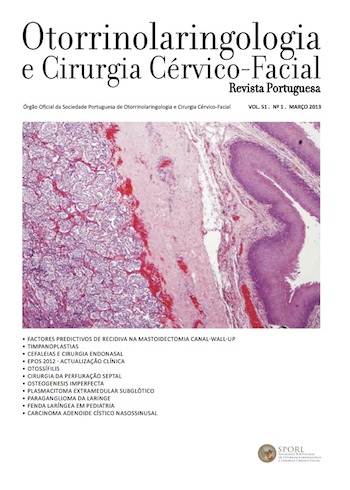Prevalence and characteristics of Positional OSA, a retrospective study
DOI:
https://doi.org/10.34631/sporl.1065Keywords:
Obstructive sleep apnea, OSA, PositionalAbstract
Objectives: To compare the prevalence of Positional Obstructive Sleep Apnea (P-OSA) based on different definitions and to identify the main factors independently associated with P-OSA and exclusive POSA (Pe-OSA).
Study Design: Retrospective study.
Material and Methods: Analysis of the type 3 polysomnography (PSG) recordings of adult patients performed between 2020 and 2021 at the Otorhinolaryngology Department of Hospital Garcia de Orta. P-OSA was defined by APOC criteria and Pe-OSA was defined as APOC I.
Results: 245 PSG were evaluated, with a mean age of 57 years and 64.9% of male patients. The prevalence of P-OSA was 55.5%, 38% of whom had Pe-OSA. Patients with P-OSA were younger (OR=0.971), slept mostly in the supine position (OR=1.031), had lower Body Mass Index (BMI) (OR=0.882), Apnea/Hypopnea Index (AHI), oxygen desaturation index (OR=0.964), mean desaturation drop, and shorter snoring time (p<0.05). The most significant predictors of Pe-OSA were a lower oxygen desaturation index (OR=0.879) and longer time in the supine position (OR=1.031).
Conclusions: Patients with P-OSA and Pe-OSA are younger, less obese and have less severe conditions, being respectively candidates for improvement or resolution of their disease using positioners.
Downloads
References
Yingjuan M, Siang WH, Leong Alvin TK, Poh HP. Positional therapy for positional obstructive sleep apnea. Sleep Med Clin. 2020 Jun;15(2):261-275. doi: 10.1016/j.jsmc.2020.02.012.
Cartwright RD. Effect of sleep position on sleep apnea severity. Sleep. 1984;7(2):110-4. doi: 10.1093/sleep/7.2.110.
Levendowski DJ, Seagraves S, Popovic D, Westbrook PR. Assessment of a neck-based treatment and monitoring device for positional obstructive sleep apnea. J Clin Sleep Med. 2014 Aug 15;10(8):863-71. doi: 10.5664/jcsm.3956.
Frank MH, Ravesloot MJ, van Maanen JP, Verhagen E, de Lange J, de Vries N. Positional OSA part 1: Towards a clinical classification system for position-dependent obstructive sleep apnoea. Sleep Breath. 2015 May;19(2):473-80. doi: 10.1007/s11325-014-1022-9.
Ravesloot MJ, Frank MH, van Maanen JP, Verhagen EA, de Lange J, de Vries N. Positional OSA part 2: retrospective cohort analysis with a new classification system (APOC). Sleep Breath. 2016 May;20(2):881-8. doi: 10.1007/s11325-015-1206-y.
Oulhaj A, Al Dhaheri S, Su BB, Al-Houqani M. Discriminating between positional and non-positional obstructive sleep apnea using some clinical characteristics. Sleep Breath. 2017 Dec;21(4):877-884. doi: 10.1007/s11325-017-1499-0.
Sabil A, Blanchard M, Annweiler C, Bailly S, Goupil F, Pigeanne T. et al. Positional obstructive sleep apnea within a large multicenter French cohort: prevalence, characteristics, and treatment outcomes. J Clin Sleep Med. 2020 Dec 15;16(12):2037-2046. doi: 10.5664/jcsm.8752.
Oksenberg A, Gadoth N, Toyras J, Leppanen T. Prevalence and characteristics of positional obstructive sleep apnea (POSA) in patients with severe OSA. Sleep Breath. 2020 Jun;24(2):551-559. doi: 10.1007/s11325-019-01897-1.
Levendowski DJ, Oksenberg A, Vicini C, Penzel T, Levi M, Westbrook PR. A systematic comparison of factors that could impact treatment recommendations for patients with Positional Obstructive Sleep Apnea (POSA). Sleep Med. 2018 Oct;50:145-151. doi: 10.1016/j.sleep.2018.05.012.
Berry RN, Albertaria CL, Harding SM, Lloyde RM, et al. The AASM Manual for the scoring of sleep and associated events: rules, terminology and technical specifications. Version 2.5. American Academy of Sleep Medicine. 2018. http://www.aasm.org.
Lee SA, Paek JH, Chung YS, Kim WS. Clinical features in patients with positional obstructive sleep apnea according to its subtypes. Sleep Breath. 2017 Mar;21(1):109-117. doi: 10.1007/s11325-016-1379-z.
Bignold JJ, Mercer JD, Antic NA, McEvoy RD, Catcheside PG. Accurate position monitoring and improved supine-dependent obstructive sleep apnea with a new position recording and supine avoidance device. J Clin Sleep Med. 2011 Aug 15;7(4):376-83. doi: 10.5664/JCSM.1194
Fietze I, Glos M, Zimmermann S, Penzel T. Long-term variability of the apnea-hypopnea index in a patient with mild to moderate obstructive sleep apnea. J Clin Sleep Med. 2020 Feb 15;16(2):319-323. doi: 10.5664/jcsm.8192.
Downloads
Published
How to Cite
Issue
Section
License
Copyright (c) 2023 The authors retain copyright of this article.

This work is licensed under a Creative Commons Attribution-ShareAlike 4.0 International License.






